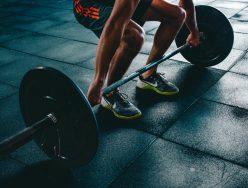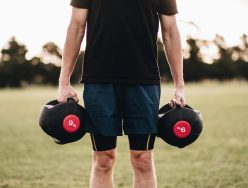“Stand up tall.”
“Shoulders up, back, and down.”
“Sit that butt down and back onto a chair”
How often do you find yourself saying these cues over and over in classes in order to “fix” your participant’s poor posture? Do you find yourself getting annoyed when you have said it for the 100th time and no one seems to be listening? Or do you find ways to dynamically correct their posture in ways that they are not aware of?
Have you ever considered that participants may completely understand and hear you, but that due to limitations in mobility or strength they physically just are not able to do what you are asking?

Over the years I have become more and more known for being a bit of a “posture junkie”. I like finding ways to help people stand taller and move easier in order to ultimately help them perform better. In that, I’ve found ways to not only encourage proper posture by the things I say but more so in the ways that I design my classes and train my clients.
Instead of cueing over and over about proper form, I get people there through drills that open the chest and strengthen the upper back (the most common cause of kyphosis – aka. “corporate America posture”). I “sneak” these drills and exercises into every class I teach, from barre to bootcamp, no one will leave my class without something that has allowed their chest to expand and their erector spinae, rhomboids, and latissimus dorsi to activate and engage.
Lower Back Pain
Did you know that 92% of American’s will have lower back problems at some points in their lives? Some of this is due to physical injuries sustained in car accidents, sports injuries, or other freak accidents, but many of this pain is due simply to weak supporting muscles and tight adjacent muscles pulling the body into an improper posture.
With this many people complaining of back pain, isn’t it our duty as fitness professionals to do something to help them. Shouldn’t we be looking at ways to reduce pain and build people up versus always breaking them down? Understanding how the vertebrae function and what you can do to improve each section is a MUST for any fitness professional who is in the industry for more than the opportunity to “get paid to workout” or because they “have a passion for exercise”.
Before I give you more, let’s check out a quick science review.
Spine Anatomy
Our backs are a complex unit of bones, muscles, ligaments, and fascia lines that all work together to create an effective and well moving body. If we pull back all the layers, we first will find the vertebrae – the bony structures that help us maintain an upright posture while protecting our spinal cord.
The vertebrae are crucial for movement, as they transmit body weight in walking and standing. Thus, it is important to understand the functions of each of the segments of the spine and keep them healthy.
Vertebral Column
I won’t bore you with all the fine details of what makes up each vertebra (the centrum, spinous process, and two transverse processes), but instead simply remind you that the spine is made up of 4 distinct sections:
- Cervical Spine: 7 bones that protect the spinal column and allow for flexion, extension, and rotation of the neck.
The muscles of the trapezius are in this region and often tight due to stress and poor neck posture.
- Thoracic Spine: 12 bones that make up the middle portion of our back and are critical for arm movement, spinal flexion/rotation, and extension, and allow us to hinge from the hips.Reduced function in the thoracic spine, due to tightness and overall stiffness, can significantly limit individuals abilities to function and perform many activities of daily living.
- Lumbar Spine: 5 bones that make up the lower back that support the body and provide stability for movements.If this area is too weak and not stable, then excessive rotation and movement can occur, ultimately putting people at risk for injury.
Saccrum & Coccyx: The 2 final areas of the spine that make up the pelvis and tail bone are fused vertebrae that support the weight of the upper body and attaches muscles that move the trunk, hips, and legs.

Putting this into action in your classes
So as you can see, any deficit in mobility, stability, and strength along the spinal column and the opposing muscles can wreak havoc on the body. Now is your time to help your participants with this.
Here are a few tips for how to do that in your next class:
- In your next class, focus on strengthening the muscles on the back side of the body (the posterior chain) while opening the muscles on the front.
- Aim to create stability in the smaller muscles with small movements opposed to only focusing on the large muscle groups. Think about ways to improve the rhomboids, glutes, and hips.
- Think about mobility in the shoulders and hips by including active dynamic warm-ups and full body movements in your classes. Remember that mobility is around a joint, while flexibility is within a muscle. A person may be flexible but lack mobility, so work on this!
- Use cues such as: “Squeeze your butt” to create engagement in the abs, help fire the glutes, and improves lordosis.
- Physically provide corrections to people versus constantly just saying a cue. Sometimes someone just needs a kinesthetic awareness brought to their misalignments and next thing you know you’ve created great posture!
Was this Article Helpful?
If this article was helpful to you, please consider linking this article to your own blog or sharing this through the social buttons below. You will also find other great articles at “Exercises“.
- 1share
- 1Facebook
- 0Twitter
- 0Pinterest
- 0LinkedIn
Summer Sides
Summer created GXunited as the ultimate resource for GX instructors after she realized there was not one single place to go to get information about certifications, conferences, choreography ideas, or blogs specifically for GX instructors. She is excited to spread her love of GX with more people through this venture! Check it out at GXunited.com and follow us on social media @GXunited.
Summer holds both an MS and BS in Kinesiology from the University of North Carolina Greensboro, as well as a BA in Dance Studies. She has achieved many of the top industry certifications, including NSCA CSCS, ACSM EP-C, ACE & AFAA GFI-C, and holds many specialty certifications, including Balanced Body Pilates Reformer, YogaFit, Schwinn Indoor Cycling, and 7 Les Mills programs.
Currently, she is traveling the nation on a nomadic adventure with her hubby and 3 puppies, while discovering new and exciting exercise ventures. Join their journey on Instagram @ournomadicadventures.
Latest posts by Summer Sides
- Breaking Up With a Client - January 12, 2017
- 5 Tips for Improving Posture in Your Classes (and a little science fun!) - October 10, 2016
- Are you a martyr to life as a fitness professional? - July 18, 2016


















